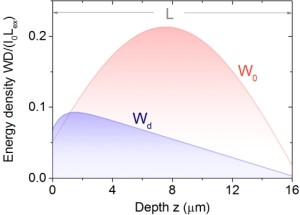Light propagating in a layer of scattering nanoparticles, shows the principles of diffusion – like tea particles in hot water. The deeper light is penetrating into the layer, the lower the energy density. Scientists of University of Twente’s Complex Photonics Group, however, manage to turn this falling diffusion curve into a rising one, by manipulating the incident light. More light energy inside an opaque layer is the result, which could lead to solar cells or LED’s with better yields. The results are published in New Journal of Physics.
Even in a medium characterized by randomness, like a collection of non-organized particles that all scatter light, the net spreading of light is uniform. This is typical for diffusion, a phenomenon physicist like Albert Einstein and Adolf Fick already were interested in. We can observe it all around us.
The randomness in the UT experiments exists of a layer of white paint. Light that’s falling on the collection of zinc oxide particles the paint is made of, will be scattered by the particles. It will start interfering with light, scattered from neighbouring particles. Nevertheless, it will spread out in a uniform way. Theoretically, the energy density will show a linear fall-off with penetration depth. The scientists of the Complex Photonics Group (MESA+ Institute for Nanotechnology) did not take this for granted and worked on a way to turn the falling curve into a rising one, thus enhancing the energy level inside the layer. Following the fundamental diffusion curve, the energy density rises until half of the layer and then falls off.
The blue curve shows the expected fall-off of energy density, with increasing penetration depth. The red enhanced diffusion curve shows a very different result, showing a sharp rise and resulting in much more energy inside the layer.
For more detail: Manipulating light inside an opaque layer
